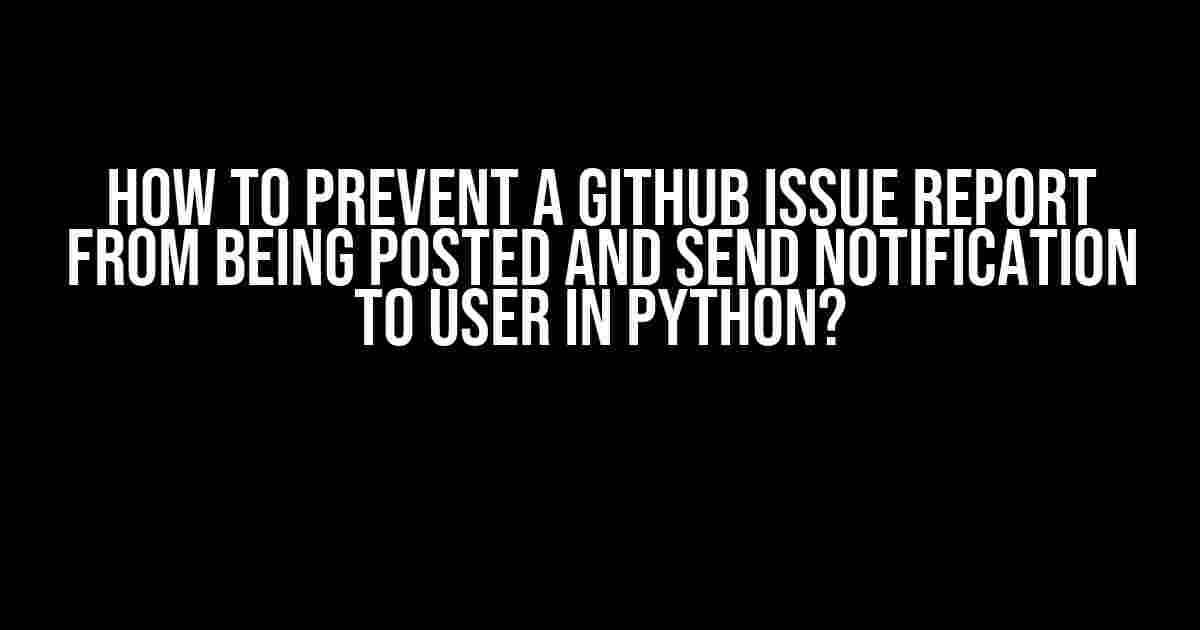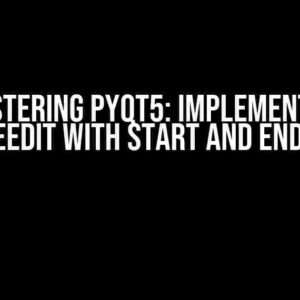Are you tired of receiving unnecessary or duplicate issue reports on your GitHub repository? Do you want to automate the process of filtering out irrelevant issues and notify the user about the status of their report? Look no further! In this article, we’ll guide you through the process of creating a Python script that prevents a GitHub issue report from being posted and sends a notification to the user.
Prerequisites
Before we dive into the coding part, make sure you have the following:
- A GitHub repository with admin access
- A Python 3.x installed on your system
- The
requestsandgithublibraries installed using pip:pip install requests github - A basic understanding of Python and GitHub API
Understanding GitHub Webhooks
GitHub webhooks are a way to receive notifications about specific events that occur in your repository, such as new issue reports, comments, or pull requests. We’ll use webhooks to capture the issue report event and prevent it from being posted if it meets certain criteria.
Here’s a high-level overview of how webhooks work:
- Github sends a POST request to your webhook URL whenever an event occurs
- Your webhook script processes the request and takes action accordingly
- Your script can respond to the request with a success or failure status
Setting up the Webhook
To set up a webhook, follow these steps:
- Go to your GitHub repository and click on
Settings>Webhooks - Click on
New webhookand enter the following details:Payload URL: the URL where your webhook script will receive the requestContent type: selectapplication/jsonEvents: selectIssues
- Click on
Add webhook
The Python Script
Now that we have our webhook set up, let’s create a Python script to process the issue report event. Create a new file called github_webhook.py and add the following code:
import json
import requests
# GitHub API token with repo access
GITHUB_TOKEN = 'your-github-token'
# GitHub repository owner and name
GITHUB_REPO_OWNER = 'your-github-username'
GITHUB_REPO_NAME = 'your-repo-name'
# Webhook secret (optional)
WEBHOOK_SECRET = 'your-webhook-secret'
def process_issue_report(request):
# Get the issue report data from the request
data = request.get_json()
issue_title = data['issue']['title']
issue_body = data['issue']['body']
# Check if the issue report meets the criteria to be prevented
if contains_spam_words(issue_title, issue_body):
# Prevent the issue report from being posted
return {'status': 'fail'}
# Allow the issue report to be posted
return {'status': 'success'}
def contains_spam_words(title, body):
# Your spam detection logic goes here
# For example, check if the title or body contains specific keywords
spam_words = ['spam', 'nonsense', 'irrelevant']
for word in spam_words:
if word in title.lower() or word in body.lower():
return True
return False
def send_notification(issue_title, username):
# Use the GitHub API to send a notification to the user
headers = {
'Authorization': f'Bearer {GITHUB_TOKEN}',
'Content-Type': 'application/json'
}
data = {
'title': f'Issue report rejected: {issue_title}',
'body': f'Your issue report was rejected due to spam detection.',
'username': username
}
response = requests.post(f'https://api.github.com/repos/{GITHUB_REPO_OWNER}/{GITHUB_REPO_NAME}/issues/comments', headers=headers, json=data)
if response.status_code == 201:
print(f'Notification sent to {username}')
else:
print(f'Error sending notification: {response.text}')
if __name__ == '__main__':
# Get the webhook request data
request_data = request.get_json()
if validate_webhook_request(request_data, WEBHOOK_SECRET):
# Process the issue report event
response = process_issue_report(request_data)
if response['status'] == 'fail':
send_notification(request_data['issue']['title'], request_data['sender']['login'])
print(f'Response: {response}')
else:
print('Invalid webhook request')
How the Script Works
The script uses the requests library to send requests to the GitHub API and the github library to interact with the GitHub API.
Here’s a breakdown of the script:
- The
process_issue_reportfunction checks if the issue report meets the criteria to be prevented (e.g., contains spam words). If it does, it returns a failure response. - The
contains_spam_wordsfunction implements the spam detection logic. - The
send_notificationfunction sends a notification to the user using the GitHub API. - The script validates the webhook request using the
validate_webhook_requestfunction. - The script processes the issue report event and sends a notification to the user if the issue report is rejected.
Running the Script
To run the script, save the github_webhook.py file and execute it using Python:
python github_webhook.py
Configuring the Webhook URL
To receive the webhook requests, you’ll need to configure a webhook URL that points to your script. You can use a service like ngrok or localhost.run to expose your local development environment to the internet.
For example, if you’re using ngrok, you can start it with the following command:
ngrok http 8080
This will create a temporary webhook URL that you can use in your GitHub webhook settings.
Testing the Script
To test the script, create a new issue report on your GitHub repository and add some spammy content to the title or body. If your script is working correctly, the issue report should be rejected and a notification should be sent to the user.
| Scenario | Expected Outcome |
|---|---|
| Issue report contains spam words | Issue report is rejected, and a notification is sent to the user |
| Issue report does not contain spam words | Issue report is posted, and no notification is sent |
Conclusion
In this article, we’ve shown you how to prevent a GitHub issue report from being posted and send a notification to the user in Python using webhooks. By implementing this script, you can automate the process of filtering out irrelevant issue reports and improve the overall quality of your repository.
Remember to modify the spam detection logic to suit your specific needs and adjust the script to fit your workflow. Happy coding!
Frequently Asked Question
Need help with GitHub issue reports? We’ve got you covered! Here are some frequently asked questions on how to prevent a GitHub issue report from being posted and send notifications to users in Python:
Q1: Can I prevent GitHub issue reports from being posted programmatically?
Yes, you can use the GitHub API to prevent issue reports from being posted. You can create a GitHub API token and use a Python library like `requests` to make API calls to GitHub. You can then use the `POST /repos/:owner/:repo/issues` endpoint to create an issue and include a `labels` field with a label that indicates the issue should not be posted.
Q2: How can I send notifications to users when an issue report is prevented from being posted?
You can use the GitHub API to send notifications to users when an issue report is prevented from being posted. You can use the `POST /repos/:owner/:repo/issues/:issue_number/comments` endpoint to create a comment on the issue and include a `@mention` to the user who tried to post the issue. You can also use a Python library like `smtplib` to send an email notification to the user.
Q3: Can I use GitHub webhooks to prevent issue reports from being posted?
Yes, you can use GitHub webhooks to prevent issue reports from being posted. You can set up a webhook to listen for `issues` events and then use a Python script to process the event and prevent the issue from being posted. You can use the `github` library in Python to handle the webhook event and make API calls to GitHub.
Q4: How can I customize the notification message sent to users when an issue report is prevented from being posted?
You can customize the notification message sent to users by using a Python template engine like `jinja2` to render a template with variables. You can then use the `smtplib` library to send an email notification with the customized message. Alternatively, you can use a third-party service like `SendGrid` to send customized email notifications.
Q5: Can I prevent issue reports from being posted based on specific conditions?
Yes, you can prevent issue reports from being posted based on specific conditions. You can use Python conditional statements to evaluate the issue report data and prevent the issue from being posted if certain conditions are met. For example, you can check the issue title, description, or labels to determine if the issue should be prevented from being posted.



![ValueError: max() iterable argument is empty [duplicate] – A Comprehensive Guide to Solving the Frustrating Error ValueError: max() iterable argument is empty [duplicate] – A Comprehensive Guide to Solving the Frustrating Error](https://rhea.hkhazo.biz.id/wp-content/uploads/sites/975/2024/07/valueerror-max-iterable-argument-is-empty-duplicate-a-comprehensive-guide-to-solving-the-frustrating-error-with-text-300x300.jpg)
